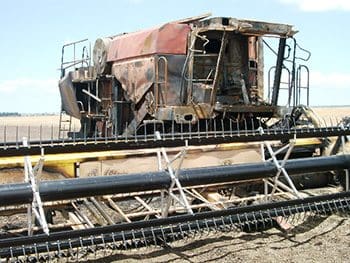IT SEEMS an unlikely combination: grain growers benefiting from advice provided by hot rod operators in the car racing industry in the interests of reducing harvester fires.

The grains industry is learning from the car racing sector when it comes to new technology, materials and designs to reduce the fire risk when machinery is operating at high temperatures. (Photo: Katrina White)
But Kondinin Group agricultural engineer, Ben White, said the grain industry was now adopting innovation from motor racing specialists when it came to new technology and materials designed to reduce fire risks.
Speaking at a Grains Research and Development Corporation update on Queensland’s Darling Downs, Mr White said the move had been fuelled by a driving need to reduce the occurrence and risk of harvester fires.
“It can be quite a contrast when you see a racing specialist arrive in a revved up vehicle to talk with a grain grower about modifying their harvester with gear found in the race car pits,” he said.
“But the simple reality is we share a common goal: to get to the finish line without our machinery suffering a catastrophic thermal event.”
He said things like heat shield paints, or fire retardant fibrous coatings, exhaust bandages or jackets and insulative double ceramic skins on the exhaust system were just some of the racing industry’s thermal barrier options now being trialled on grain harvesters.
“It is important growers check first whether modifications like these will impact their warranties, but they are just some of the tools coming into play to help us reduce the risk of harvester fires.”
Mr White said harvester fires could damage equipment, destroy crop and infrastructure and endanger lives.
“Larger plantings of pulse crops in recent years, driven by favourable pricing has further elevated the risk,” he said.
“Research by the late Dr Graham Quick indicates winter pulse crops are up to five times more fire prone than wheat during harvest.”
Mr White said Australian growers were largely ‘on their own’ in a sense, in terms of harvesting in conditions conducive to fires, which meant international harvester manufacturers were less likely to specifically alter vehicle design or materials in response to the needs of Australian growers.
“However, while we are trialling and evaluating some of those technologies and materials from the racing sector, there are practical things growers can do during harvest to reduce their fire risk this season.”
“But there are a number of elements that add to the risk of fire on harvesting machinery. Most of these can be monitored, maintained, addressed and ultimately fire risk can be significantly reduced.”
He said the Kondinin Group had conducted research which found the major causes for approximately 50 per cent of fires on harvesters were a) dust and trash build-up on the machine and b) bearing failures. Mechanical failures are also implicated in one in 12 harvester fires.
To reduce the risk of harvester fires:
- Regularly cleaning down machinery to reduce fuel load
- Monitoring bearings with an infrared temperature gun
- Monitor ambient conditions and the fire danger index
- Consider heat shield or exhaust modifications, such as
- Exhaust paints, or coatings including ceramics and alumina silica which can minimise dust adhesion and reduce hot component surface temperatures
- Exhaust bandages and blankets which are designed to insulate exhaust components
- Double skins on the exhaust system (which are insulative, like a thermos)
- Ensure an electrical isolator system is used
- Ensure fuel system is well maintained
- Maintain and keep airflow systems clear
- Check concave doors are well sealed (minimise dust leakage which may in turn contact hot surfaces)
- Ensure your harvest team has a plan and knows their individual responsibilities in the event of a fire
- If your harvester does catch fire pull out of the paddock and call 000.
Source: GRDC




Try to purchase some decent ,aftermarket exhaust wrapping, and the like. You will be treated to platitudes,and mysterious looks. The rhetoric has moved far in advance of the requirements.